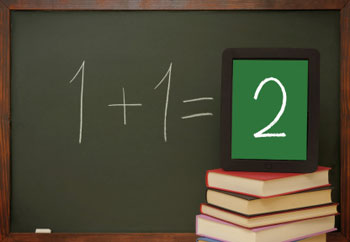Math Measurement Help for Struggling Students
Measurements are taken in both math and science, so if you're struggling with measurement, it may damage your grades in both subjects. Keep reading for an overview of the math measurement skills you'll learn in elementary school.

Help with Measurement
First Grade
In first grade, you'll be introduced to the concept of length, which is the distance from one point in space to another point. Length is always measured in units, such as inches or feet. For instance, you might be three feet tall.
Second Grade
You'll learn to measure objects in second grade, and you'll also explore the different units of length. These units include inches and centimeters, which are for shorter items. Feet, meters and yards are for longer items.
A measuring stick is a tool that you can use to measure items. It will be marked with a certain unit, like inches or centimeters, and you'll compare the length of your object to the stick. Be sure that one end of the stick is lined up with one end of the object you're measuring. Find the number on the ruler that's closest to the other end of the object. This number is its length.
Third Grade
In third grade, you'll learn to measure objects using multiple dimensions. For example, you can measure perimeter, which is the sum of the lengths of a 2-dimensional object's sides. You can also measure area, which is the total amount of space a 2-dimensional object covers. Area is calculated by multiplying the object's length by its width. Perimeter is expressed in units of length, like inches and meters, while area is reported in square units, like square centimeters and square feet.
You'll also study mass, which is measured in units called grams and kilograms. Mass is commonly used to express how heavy something is. Liquid volume is the amount of space that a liquid takes up, and it's often measured in units called liters.
Fourth Grade
Fourth graders learn about the different systems of measurement, as well as the units within each system. The customary system uses inches, feet and miles to measure length, and it uses ounces and pounds to measure weight. For measuring liquid volume, quarts and gallons are used.
The metric system uses centimeters, meters and kilometers for length, and its units of mass include grams and kilograms. Liquid volume is typically measured using milliliters and liters.
Fifth Grade
In fifth grade, your study of measurement will focus on converting between different units. You'll learn about conversion factors, which tell you how many of one unit it takes to make up another unit. Here are a few commonly used conversion factors for metric units:
1 kilogram = 1,000 grams
1 kilometer = 1,000 meters
1 liter = 1,000 milliliters
To convert a measurement given in smaller units into larger units, you'll divide by the conversion factor. To convert a measurement given in larger units into smaller units, you'll multiply by the conversion factor. For instance, 3,000 milliliters = 3 liters because 3,000 ÷ 1,000 = 3. Likewise, 5 kilometers = 5,000 meters because 5 x 1,000 = 5,000.
Other Articles You May Be Interested In
-
Tips for Helping Your Fifth Grader with Measurements in Math Homework

Measurement is a math skill that most fifth graders are required to master. In this country, this process can be especially complex because most kids must learn two distinct systems. Read on to find out how to help your child master metric and U.S. measurements.
-
MIND Games Lead to Math Gains

Imagine a math teaching tool so effective that it need only be employed twice per week for less than an hour to result in huge proficiency gains. Impossible, you say? Not so...and MIND Research Institute has the virtual penguin to prove it.
We Found 7 Tutors You Might Be Interested In
Huntington Learning

- What Huntington Learning offers:
- Online and in-center tutoring
- One on one tutoring
- Every Huntington tutor is certified and trained extensively on the most effective teaching methods
K12

- What K12 offers:
- Online tutoring
- Has a strong and effective partnership with public and private schools
- AdvancED-accredited corporation meeting the highest standards of educational management
Kaplan Kids

- What Kaplan Kids offers:
- Online tutoring
- Customized learning plans
- Real-Time Progress Reports track your child's progress
Kumon

- What Kumon offers:
- In-center tutoring
- Individualized programs for your child
- Helps your child develop the skills and study habits needed to improve their academic performance
Sylvan Learning

- What Sylvan Learning offers:
- Online and in-center tutoring
- Sylvan tutors are certified teachers who provide personalized instruction
- Regular assessment and progress reports
Tutor Doctor

- What Tutor Doctor offers:
- In-Home tutoring
- One on one attention by the tutor
- Develops personlized programs by working with your child's existing homework
TutorVista

- What TutorVista offers:
- Online tutoring
- Student works one-on-one with a professional tutor
- Using the virtual whiteboard workspace to share problems, solutions and explanations